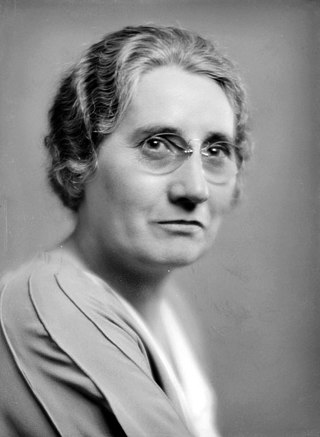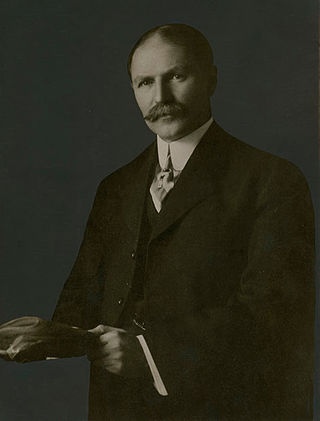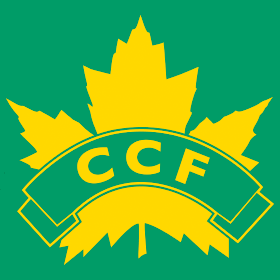Related Research Articles

The 1921 Canadian federal election was held on December 6, 1921, to elect members of the House of Commons of Canada of the 14th Parliament of Canada. The Union government that had governed Canada through the First World War was defeated, and replaced by a Liberal government under the young leader William Lyon Mackenzie King. A new third party, the Progressive Party, won the second most seats in the election.

Agnes Campbell MacPhail was a Canadian politician and the first woman elected to Canada's House of Commons. She served as a Member of Parliament (MP) from 1921 to 1940; from 1943 to 1945 and again from 1948 to 1951, she served as a member of the Legislative Assembly of Ontario, representing the Toronto riding of York East. Active throughout her life in progressive politics, Macphail worked for multiple parties, most prominently the Progressive Party and the Co-operative Commonwealth Federation. She promoted her ideas through column-writing, activist organizing, and legislation.

The Communist Party of Canada is a federal political party in Canada, founded in 1921 under conditions of illegality. Although it does not currently have any parliamentary representation, the party's candidates have previously been elected to the House of Commons, the Ontario legislature, the Manitoba legislature, and various municipal governments across the country. The party has also made significant contributions to Canada's trade union, labour, and peace movements.
Unity, United Progressive Movement and United Reform were the names used in Canada by a popular front party initiated by the Communist Party of Canada in the late 1930s.

Dorise Winifred Nielsen was a Canadian communist politician, feminist and teacher.

George Black was an administrator and politician in Yukon, Canada. He went to Yukon in 1898 during the Gold Rush and prospected for gold, making a fortune and losing it when his claim was swept away in a flood. He then established a law practice in Dawson City. He was elected to the Yukon Territorial Council in 1905, and first ran for the House of Commons of Canada in the 1908 federal election but was defeated.

The Co-operative Commonwealth Federation – The Farmer-Labor Party of Ontario, or more commonly known as the Ontario CCF, was a democratic socialist provincial political party in Ontario that existed from 1932 to 1961. It was the provincial wing of the federal Co-operative Commonwealth Federation (CCF). The party had no leader in the beginning, and was governed by a provincial council and executive. The party's first Member of the Legislative Assembly (MLA) was elected by voters in the 1934 Ontario general election. In the 1937 general election, no CCF members were elected to the Ontario Legislature. In 1942, the party elected Toronto lawyer Ted Jolliffe as its first leader. He led the party to within a few seats of forming the government in the 1943 general election; instead, it formed the Official Opposition. In that election, the first two women were elected to the Ontario Legislature as CCFers: Agnes Macphail and Rae Luckock. The 1945 election was a setback, as the party lost most of its seats in the Legislature, including Jolliffe's seat. The party again became the Official Opposition after the 1948 general election, and defeated the Conservative premier George Drew in his seat, when Bill Temple unexpectedly won in the High Park constituency. The middle and late 1940s were the peak years for the Ontario CCF. After that time, its electoral performances were dismal, as it was reduced to a rump of two seats in the 1951 election, three seats in the 1955 election, and five seats in the 1959 election. Jolliffe stepped down as leader in 1953, and was replaced by Donald C. MacDonald.
Margaret Rae Morrison Luckock known as Rae Luckock was a feminist, social justice activist, peace activist and, with Agnes Macphail, one of the first two women elected to the Legislative Assembly of Ontario, in 1943. A member of the Co-operative Commonwealth Federation, also known as the Ontario CCF, Luckock was elected to the Ontario legislature in the 1943 Ontario general election representing Toronto's Bracondale constituency (riding). She served as a Member of Provincial Parliament (MPP) until she was defeated in the 1945 Ontario general election. She became the Congress of Canadian Women's founding president in 1950, and became a victim of the Cold War's anti-communist hysteria when she was denied entry into the United States, because she travelled to "Red" China and invited Soviet women to visit Canada. She contracted Parkinson's disease in the mid-1950s and mostly was bedridden until her death in 1972.
Gender representation has been a significant issue in Canadian politics.
The Labor-Progressive Party was the legal front of the Communist Party of Canada from 1943 to 1959.
Women were first allowed to vote at the federal level in Canada in the 1917 general election in connection with military service, and were allowed to vote under the same conditions as men beginning on May 24, 1918. The next four elections saw only one woman elected: Agnes Macphail. The 1936 election saw two women in the House together for the first time. A by-election in 1941 saw a woman elected to the governing caucus for the first time. The 22nd federal election in 1953 was a slight breakthrough, electing four women, which was 1.5% of the House. Every Parliament thenafter would have at least two women at a time, except for the 28th Parliament from 1968 to 1972, in which Grace MacInnis was the only woman. Then 30th Parliament, elected in 1974, was another breakthrough, containing nine women MPs following the general election and rising to ten due to a by-election in 1976. The number of women in the House would not fall below ten again.
The 14th Canadian Parliament was the first Canadian parliament where a woman sat as a member. Women first became eligible to hold seats in the Canadian House of Commons on July 7, 1919. In the 1921 federal election, four women ran for seats in the House of Commons. Agnes Macphail was elected for a rural constituency in Ontario, becoming the first woman to hold a seat in the Canadian parliament.
During the 15th Canadian Parliament, there was no change in representation by women. Four women ran for seats in the Canadian House of Commons in the 1925 federal election but Agnes Macphail, first elected in 1921, continued to be the only woman elected.
During the 16th Canadian Parliament, women sat as members for the first time in both the House of Commons and the Senate. Two women ran for seats in the Canadian House of Commons in the 1926 federal election but Agnes Macphail, first elected in 1921, continued to be the only woman elected.
During the 17th Canadian Parliament, the number of sitting women senators increased. Ten women ran for seats in the Canadian House of Commons in the 1930 federal election but Agnes Macphail, first elected in 1921, continued to be the only woman elected. Cairine Wilson continued to sit as a member of the Senate.
During the 18th Canadian Parliament, two women sat in the House of Commons for the first time. Sixteen women ran for seats in the Canadian House of Commons in the 1935 federal election. Agnes Macphail, first elected in 1921, was reelected in the newly created riding of Grey—Bruce. Martha Black, running in the place of her sick husband George Black as an independent Conservative, was elected for the Yukon riding, becoming the second woman to be elected to the House of Commons. Cairine Wilson and Iva Campbell Fallis continued to sit as members of the Senate.
The 43rd Canadian Parliament once again set a record number of female Members of Parliament, with 98 women elected to the 338-member House of Commons of Canada (28.9%) in the 2019 election. Of those 98 women, 31 were elected for the first time in the 2019 election. 2 more women were elected in by-elections in October 2020, reaching the historic milestone of 100 women in the House of Commons for the first time. This represents a gain of twelve seats over the previous record of 88 women in the 42nd Canadian Parliament. By contrast, the 116th United States Congress had 102 women sitting in the 435-seat United States House of Representatives (23.4%).

Rosemarie Ashley Falk is a Canadian politician from Saskatchewan, who has represented the riding of Battlefords—Lloydminster in the House of Commons of Canada since a by-election victory in 2017. She is a member of the Conservative Party of Canada caucus. Falk currently serves as the Deputy Shadow Minister for Families, Children and Social Development and Status of Women.
The 44th Canadian Parliament includes a record number of female Members of Parliament, with 103 women elected to the 338-member House of Commons of Canada (30.5%) in the 2021 election. Of those 103 women, 22 were elected for the first time in the 2021 election. This represents a gain of five seats over the previous record of 98 women elected at the beginning of the 43rd Canadian Parliament, and a gain of three seats from the record high of 100 women during the previous parliamentary session following by-elections.
References
- ↑ "North Battleford MP Dorise Nielsen was first Communist in Parliament". Star Phoenix. April 27, 2017.
- ↑ "Agnes Macphail". The Canadian Encyclopedia .
- ↑ "George Black". Yukon Nuggets. Hougen Group of Companies.
- ↑ Mardon, Ernest G; Mardon, Austin Albert (2012). Who's Who in Federal Politics in Alberta. pp. 63–64. ISBN 978-1897472194.
- ↑ Parliament of Canada: Women Candidates in General Elections